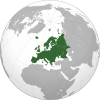Flag of Spain
Traditionally, the middle stripe was defined by the more archaic term of gualda, and hence the popular name la Rojigualda (red-weld).
[2] The flag remained marine-focused for most of the next 50 years and flew over coastal fortresses, marine barracks and other naval property.
During the Peninsular War, the flag could also be found on marine regiments fighting inland and it was raised by many Spaniards as a symbol of resistance.
[3] From 18th century to nowadays, the colour scheme of the flag remained intact, with the exception of the Second Republic period (1931–1939); the only changes centred on the coat of arms.
It can be flown from public buildings, private homes, businesses, ships, town squares, or during official ceremonies.
The first method, commonly known as half-masting, is performed when the flag is hoisted to the top of the flagpole, then lowered to the pole's one-third position.
[4] Some high-ranking officials of the Spanish state (i.e., the president, the vice-presidents and the ministers of the government, or the chairmen of the Congress of Deputies and the Senate) are entitled to display a flag representative of their status.
The Yacht ensign is the flag of Spain charged with the royal crown in blue in the centre of the yellow stripe.
The Spanish naval jack is hoisted at the prow of all Navy ships when docked or anchored in foreign waters, from sunrise to sunset.
It was frequently made up of other different flags, full of images and symbols that represented all the values that the troops or the King defended.
In Spain the medieval kingdoms which merged in the sixteenth century had their own heraldic symbols and their navies used to display their own flags and standards on both the Mediterranean Sea and the Atlantic Ocean, where the Aragonese and Castilian Crowns had their respective areas of influence.
The Crown of Castile, since the final union between the kingdoms of Castile and León in 1230, used a quartered flag alternating the Castilian (Gules, a tower Or, masoned sable and ajouré azure) and Leonese (Argent, a lion rampant purpure crowned or, langued and armed gules) emblems.
Aragonese and Castilian flags and coats of arms merged when the Catholic monarchs created the new symbols of their personal union of the crowns in 1475.
When the House of Habsburg took the Spanish throne by mid-16th century each military company had its own flag in which appeared usually the arms of its commander over the Cross of Burgundy.
[16] When Philip II came to power, he ordered[citation needed] that, in addition to the flags of each company, each Tercio should have another one in yellow with the Cross of Burgundy in red.
Some examples are the flag of Santiago (Saint James the Great), the green one the Emperor took during the conquest of Tunisia or the crimson one used by Hernán Cortés in Mexico.
He was the first to give Spain a unified symbol of its own when putting on white fabric the Cross of Burgundy and the Royal coat of arms.
When Charles III became King of Spain, he observed that most of the countries in Europe used flags which were predominantly white and, since they were frequently at war with each other, lamentable confusions occurred at sea, as if was difficult to determine if a sighted ship were enemy until practically the last moment.
[1] For this reason, he ordered his Minister of the Navy to present several designs of flags to him, which needed to be visible from great distances.
[1] [19] Despite popular belief that the colours which constitute the Spanish flag were derived from the standard of the Crown of Aragon, there is no written evidence to support this.
Formed by three horizontal strips of the same width, red, yellow and morado, with the coat of arms of the Second Spanish Republic at the centre (quarterly of Castile, Leon, Aragon and Navarre, Enté en point for Granada, stamped by a mural crown between the two Pillars of Hercules).
The Republican regime in Spain was destroyed and Francisco Franco became the Caudillo of the country and remained in power until his death on 20 November 1975.










